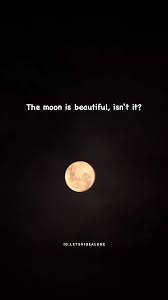The moon, Earth’s closest celestial neighbor, has captivated the human imagination for millennia. Its luminous presence in our night sky has inspired countless myths, artworks, and scientific inquiries. The phrase “the moon is beautiful, isn’t it?” encapsulates not just an observation but a shared human experience, one that transcends cultures, languages, and geographical barriers. In this article, we delve into the multifaceted beauty of the moon, exploring its scientific significance, its role in cultural expressions, and the ongoing exploration that seeks to uncover its many mysteries.
The Science Behind the Moon’s Allure
The beauty of the moon is not merely aesthetic; it’s deeply rooted in its scientific significance and the role it plays in Earth’s natural phenomena. The moon orbits Earth at an average distance of about 384,400 kilometers (238,855 miles), a proximity that profoundly influences our planet. The gravitational pull between the Earth and the moon is responsible for the tides. As the moon orbits Earth, its gravity pulls on the planet’s oceans, causing high and low tides. This lunar influence extends beyond the tides, affecting the Earth’s rotation and contributing to the stability of our planet’s axial tilt, which in turn, moderates our climate.
Furthermore, the moon’s phases provide a visible calendar, historically guiding agricultural practices and marking time for ancient civilizations. The cycle from new moon to full moon and back again has served as a fundamental way to understand time and seasons for millennia. Each phase of the moon, from the slender crescent to the full, bright orb, offers a different kind of beauty and a reminder of the celestial dynamics that operate beyond our immediate perception.
The Moon in Art and Literature
The moon’s beauty transcends scientific fascination, deeply influencing art, literature, and folklore around the world. Its presence in the night sky has been a source of inspiration for poets, writers, and artists, serving as a symbol of love, longing, change, and immortality. The famous Japanese phrase, “the moon is beautiful, isn’t it?”, thought to be a subtle way of expressing love, highlights the moon’s role in conveying deep emotions and connections beyond the literal meanings of words.
In Western literature, the moon has often been personified or used as a backdrop to explore themes of mystery, madness, and transformation. From Shakespeare’s romantic scenes bathed in moonlight to the werewolf legends that associate transformation with the full moon, the celestial body has been a versatile and powerful symbol in storytelling.
Visual arts, too, have been captivated by the moon’s ethereal beauty. Ancient paintings, modern photographs, and digital art continue to explore the moon’s visual and symbolic potential, capturing its phases, its pale light in the dark sky, and the way it interacts with landscapes on Earth.
Lunar Exploration and Human Fascination
Humanity’s fascination with the moon has driven us not just to observe and depict it, but to reach out and walk on its surface. The Apollo missions of the 1960s and ’70s marked the culmination of human dreams and scientific ambition, turning the moon from a distant object of wonder into a place of human exploration. These missions returned with scientific data and lunar samples that have provided invaluable insights into the solar system’s history.
Today, the exploration of the moon continues with missions from countries around the globe, aiming not only to learn more about the moon itself but also to use it as a stepping stone for future space exploration. The prospect of establishing a permanent human presence on the moon, as part of projects like NASA’s Artemis program, opens up new possibilities for scientific discovery and challenges our imaginations to envision what life might be like living and working on another world.
The Enduring Beauty of the Moon
“The moon is beautiful, isn’t it?” This simple question reflects a universal human experience. Whether observed from a quiet countryside or glimpsed between the buildings of a bustling city, the moon remains a source of wonder. Its beauty lies not just in its visual appearance but in its ability to connect us to the vast universe beyond our own planet. It reminds us of the mysteries that still await discovery in the night sky and the shared curiosity that drives us to explore them.
In conclusion, the moon’s beauty is multifaceted, blending scientific intrigue with artistic inspiration and the spirit of exploration. It stands as a testament to the wonders of the cosmos and our persistent endeavor to understand them. As we continue to gaze upon the moon, let us remember the countless generations that have done the same, finding in its luminous presence a source of inspiration, wonder, and connection.
Read Also: How to Use Amazon Gift Card: A Comprehensive Guide









